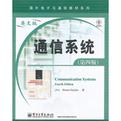通信系统
出版时间:2012-11 出版社:电子工业出版社 作者:西蒙·赫金 页数:816
Tag标签:无
内容概要
本书对通信系统的基础理论和关键环节进行了深入分析,力图让学生在讨论中领会通信的精髓。全书首先给出通信系统的梗概及需要研究的关键技术,接着分章详细讨论了随机过程、连续波调制、脉冲调制、基带脉冲传输、信号空间分析、带通数字传输、扩频调制、多用户无线通信、信息论基础和差错控制编码等,各章都附有大量的习题,便于学生实践。本书强调通信理论的统计基础,并给出了用MATIAB模拟的8个计算机实验,这些实验几乎覆盖了各章节的主要内容,形成了独特的通信理论“软件实验室”。 本书可作为高等院校通信类、信息类、电子类、计算机类等专业高年级本科生的教材,也可供有关技术,科研和管理人员参考。
作者简介
Simon Haykin,IEEE会士,毕业于英国伯明翰大学电子工程系。加拿大McMaster大学电子与计算机工程系教授,通信研究实验室主任。研究方向包括非线性动力学、神经网络和自适应滤波器及其应用。
书籍目录
BACKGROUND AND PREVIEW 1. The Communication Process 2. Primary Communication Resources 3. Sources of Information 4. Communication Networks 5. Communication Channels 6. Modulation Process 7. Analog and Digital Types of Communication 8. Shannons Information Capacity Theorem 9. A Digital Communication Problem 10. Historical Notes Notes and References CHAPTER 1 Random Processes 1.1 Introduction 1.2 Mathematical Definition of a Random Process 1.3 Stationary Processes 1.4 Mean, Correlation, and Covariance Functions 1.5 Ergodic Processes 1.6 Transmission of a Random Process Through a Linear Time-Invariant Filter 1.7 Power Spectral Density 1.8 Gaussian Process 1.9 Noise 1.10 Narrowband Noise 1.11 Representation of Narrowband Noise in Terms of In-phase and Quadrature Components 1.12 Representation of Narrowband Noise in Terms of Envelope and Phase Components 1.13 Sine Wave Plus Narrowband Noise 1.14 Computer Experiments: Flat-Fading Channel 1.15 Summary and Discussion Notes and References Problems CHAPTER 2 Continuous-Wave Modulation 2.1 Introduction 2.2 Amplitude Modulation 2.3 Linear Modulation Schemes 2.4 Frequency Translation 2.5 Frequency-Division Multiplexing 2.6 Angle Modulation 2.7 Frequency Modulation 2.8 Nonlinear Effects in FM Systems 2.9 Superheterodyne Receiver 2.10 Noise in CW Modulation Systems 2.11 Noise in Linear Receivers using Coherent Detection 2.12 Noise in AM Receivers using Envelope Detection 2.13 Noise in FM Receivers 2.14 Computer Experiments: Phase-Locked Loop 2.15 Summary and Discussion Notes and References Problems CHAPTER 3 Pulse Modulation 3.1 Introduction 3.2 Sampling Process 3.3 Pulse-Amplitude Modulation 3.4 Other Forms of Pulse Modulation 3.5 Bandwidth-Noise Trade-off 3.6 Quantization Process 3.7 Pulse-Code Modulation 3.8 Noise Considerations in PCM Systems 3.9 Time-Division Multiplexing 3.10 Digital Multiplexers 3.11 Virtues, Limitations, and Modifications of PCM 3.12 Delta Modulation 3.13 Linear Prediction 3.14 Differential Pulse-Code Modulation 3.15 Adaptive Differential Pulse-Code Modulation 3.16 Computer Experiment: Adaptive Delta Modulation 3.17 MPEG Audio Coding Standard 3.18 Summary and Discussion Notes and References Problems CHAPTER 4 Baseband Pulse Transmission 4.1 Introduction 4.2 Matched Filter 4.3 Error Rate Due to Noise 4.4 Intersymbol Interference 4.5 Nyquists Criterion for Distortionless Baseband Binary Transmission 4.6 Correlative-Level Coding 4.7 Baseband M-ary PAM Transmission 4.8 Digital Subscriber Lines 4.9 Optimum Linear Receiver 4.10 Adaptive Equalization 4.11 Computer Experiments: Eye Patterns 4.12 Summary and Discussion Notes and References Problems CHAPTER 5 Signal-Space Analysis 5.1 Introduction 5.2 Geometric Representation of Signals 5.3 Conversion of the Continuous AWGN Channel into a Vector Channel 5.4 Likelihood Functions 5.5 Coherent Detection of Signals in Noise: Maximum Likelihood Decoding 5.6 Correlation Receiver 5.7 Probability of Error 5.8 Summary and Discussion Notes and References Problems CHAPTER 6 Passband Digital Transmission 6.1 Introduction 6.2 Passband Transmission Model 6.3 Coherent Phase-Shift Keying 6.4 Hybrid Amplitude/Phase Modulation Schemes 6.5 Coherent Frequency-Shift Keying 6.6 Detection of Signals with Unknown Phase 6.7 Noncoherent Orthogonal Modulation 6.8 Noncoherent Binary Frequency-Shift Keying 6.9 Differential Phase-Shift Keying 6.10 Comparison of Digital Modulation Schemes Using a Single Carrier 6.11 Voiceband Modems 6.12 Multichannel Modulation 6.13 Discrete Multitone 6.14 Synchronization 6.15 Computer Experiments: Carrier Recovery and Symbol Timing 6.16 Summary and Discussion Notes and References Problems CHAPTER 7 Spread-Spectrum Modulation 7.1 Introduction 7.2 Pseudo-Noise Sequences 7.3 A Notion of Spread Spectrum 7.4 Direct-Sequence Spread Spectrum with Coherent Binary Phase-Shift Keying 7.5 Signal-Space Dimensionality and Processing Gain 7.6 Probability of Error 7.7 Frequency-Hop Spread Spectrum 7.8 Computer Experiments: Maximal-Length and Gold Codes 7.9 Summary and Discussion Notes and References Problems CHAPTER 8 Multiuser Radio Communications 8.1 Introduction 8.2 Multiple-Access Techniques 8.3 Satellite Communications 8.4 Radio Link Analysis 8.5 Wireless Communications 8.6 Statistical Characterization of Multipath Channels 8.7 Binary Signaling over a Rayleigh Fading Channel 8.8 TDMA and CDMA Wireless Communication Systems 8.9 Source Coding of Speech for Wireless Communications 8.10 Adaptive Antenna Arrays for Wireless Communications 8.11 Summary and Discussion Notes and References Problems CHAPTER 9 Fundamental Limits in Information Theory 9.1 Introduction 9.2 Uncertainty, Information, and Entropy 9.3 Source-Coding Theorem 9.4 Data Compaction 9.5 Discrete Memoryless Channels 9.6 Mutual Information 9.7 Channel Capacity 9.8 Channel-Coding Theorem 9.9 Differential Entropy and Mutual Information for Continuous Ensembles 9.10 Information Capacity Theorem 9.11 Implications of the Information Capacity Theorem 9.12 Information Capacity of Colored Noise Channel 9.13 Rate Distortion Theory 9.14 Data Compression 9.15 Summary and Discussion Notes and References Problems CHAPTER 10 Error-Control Coding 10.1 Introduction 10.2 Discrete-Memoryless Channels 10.3 Linear Block Codes 10.4 Cyclic Codes 10.5 Convolutional Codes 10.6 Maximum Likelihood Decoding of Convolutional Codes 10.7 Trellis-Coded Modulation 10.8 Turbo Codes 10.9 Computer Experiment: Trubo Decoding 10.10 Low-Density Parity-Check Codes 10.11 Irregular Codes 10.12 Summary and Discussion Notes and References Problems APPENDIX 1 Probability Theory APPENDIX 2 Representation of Signals and Systems APPENDIX 3 Bessel Functions APPENDIX 4 Confluent Hypergeometric Functions APPENDIX 5 Cryptography APPENDIX 6 Tables GLOSSARY BIBLIOGRAPHY INDEX
图书封面
图书标签Tags
无
评论、评分、阅读与下载
用户评论 (总计13条)
- 学习通信系统的精典教材
- 这本书是我们的教材。首次在当当购物,购物体验不错!
- 书本知识专业全面···内容严谨···
- 经典教材,应该不错。
- 关于书,我想不用多说了吧~~会买这个书的估计也是和我一样用来当教材的吧!书很好,全新的,尤其是发货速度。昨天晚上下的单,今天就到了,惊喜!!!!这个书学校旁边的书店只有中文版的,当当网帮了大忙了,感谢~~
- 内容不错,印刷很差
- 我看不懂啊啊啊啊啊!!!但他说很有用!!!不错!!!
- 发货速度很快,书质量也很好
- 英语有点难度,但却挺实用的啊……
- 讲述不同通信系统,印刷质量一般
- 给别人买的,感觉书不错,订单处理也及时,很快就收到货了,下次还在你们这里买,感觉不错
- 书的包装引起书面损坏
希望改进 - 就是 还行吧
推荐图书
- 惊艳新疆
- 特殊群体大学生的教育引导研究
- 一级注册建筑师必备规范汇编(修订缩印本) (其他)
- 中国百名一级注册建筑师作品选 2 (其他)
- 经典成语100则
- 上海楼盘与购房指南(7) (平装)
- 上海楼盘与购房指南 (平装)
- 中华茶之道
- ロマンス タムくんのラブストーリー短編集
- 爱的100条法则
- 威海市统计志
- 中国大企业集团竞争力年度报告
- 房地产建设费用 (平装)
- 泰国经典游
- 20世纪英美小说流变与选读
- 中国经济波动和宏观调控研究 (平装)
- 小妾当然不如妻
- GNSS定位技术在水利水电工程中的应用
- 大学物理(上下)
- 写字课
- 科技文献共享与服务
- 穿过雨季的伞
- 人文世界(第3辑)
- 初中考题同步导解(初一英语) (平装)
- 土默热红学新突破
